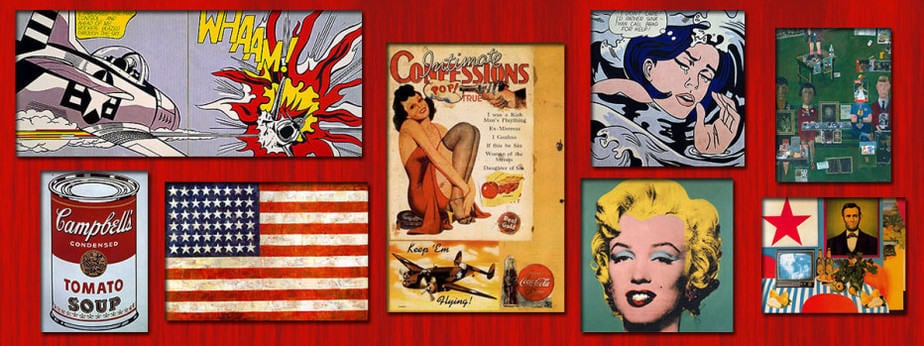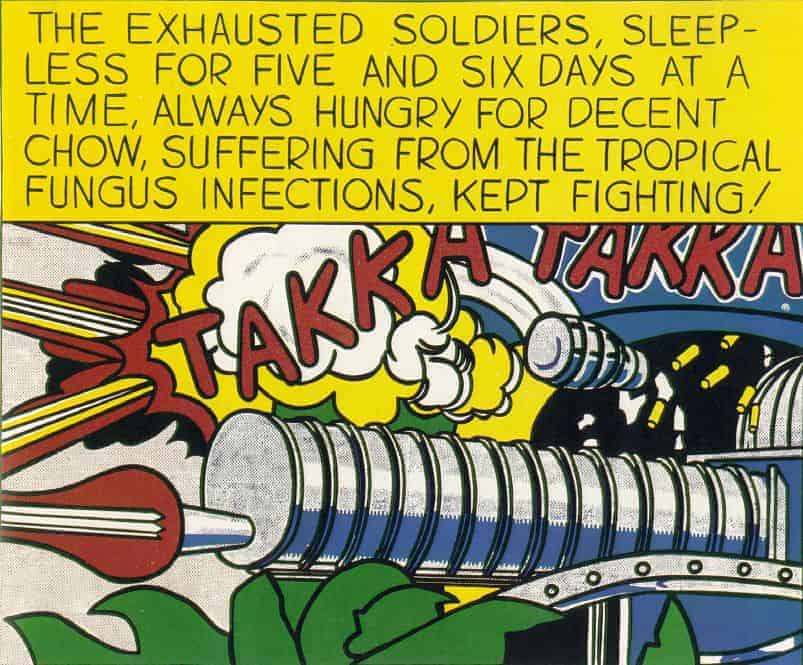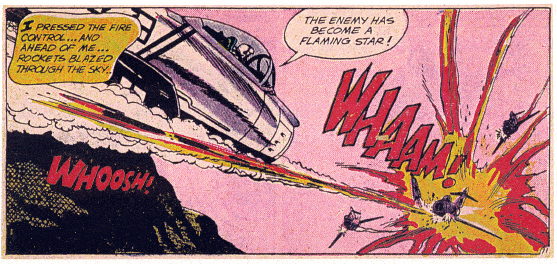Popular culture was shrouding everything in the 1950’s and 60’s in America, and maintaining the status quo became more important than ever. The power of pop art has been emerging since then and continuously breaking all conformist perspectives of art
The post-war era seems old fashioned to us now, but at that time, humanity was experiencing life in ways that adults of the time could not have even conceived of as children. With a new world, came new perspectives, new attitudes, and new lingo. How else to describe the visual expression of the era than to use that lingo?
Lawrence Alloway, a British art critic, did just that when he coined the term POP- art in reference to art that mimicked consumerism and popular culture.
The world had become so super conformist that every house, yard, and even personal appearance looked the same.
Advertising was pervasive and marketed to the public false images of lives they were trying so hard to emulate but never could. The result was an undercurrent running through most of the households that were resulting in increased alcoholism in men and nervous breakdowns and dependence on pills in women.
Adults of the era had grown up on hard work and very little comfort during the depression but now they had machines that did work for them and convenience products that seemed to come from abundance they didn’t know what to do with.

The avant-garde thinkers, the beatniks, and social activists in the nation’s cultural hubs took notice of the hypocrisy of idealized images, television programs, and adored celebrities that the public was trying so hard to imitate. They saw current trends as homogenization and suffocation of humanity, innovation, and creativity. They began to attempt to expose the absurdity of conformity.
Pop Art Simplified
Artists, primarily from Britain and America, started creating art using the very items and mediums that pop culture had been using to manipulate the masses into complacency and mass consumerism. The bold primary colors and simple graphics of the era’s packaging designs, and often the packages themselves, were used to create pieces that are well known today, such as Brillo boxes and Campbell’s Soup cans. It was a complete departure and almost the very opposite of the other giant art movement of the day – Abstract Expressionism.
Whereas abstract artists sought to let the medium control the image, such as in Pollock’s drops of paint, Pop Artists went beyond realism into reality.
While abstract expressionists used their work to draw out of the viewer an acknowledgment of the tragedies of the post-war, post-depression era, pop artists were revealing the effects of the trauma of recent decades in the trends of the current time. The effect was poignant, revolutionary, and exposed the fragility of emotional façade.
Pop artists worked in imitation, using the graphic styles of the era, the format of popular comics, and the expressions of popular fashion models and celebrities to convey their messages. Though it was an imitation, it was not collage – these were seasoned artists whose talents for more detailed work were previously known. They achieved the look of these works with silk screening and even paint.
As pop artist Roy Lichtenstein put it, “Pop Art looks out into the world. It doesn’t look like a painting of something; it looks like the thing itself.” The first pop artist, Richard Hamilton, defined pop art in the irony and wit of pop art itself: “Pop Art is: popular, transient, expendable, low-cost, mass-produced, young, witty, sexy, gimmicky, glamorous, and Big Business.
Pop-art pieces were not mere reproductions of objects and advertisements. Each piece was infused with clever wit, irony, and a subtle message that became apparent to the observer. Sometimes it was revealed through the isolation of the item from its usual environment, and sometimes it was more obvious with text or contextual clues.
TAKKA TAKKA
The essence and complete elements of pop art are found in Roy Lichtenstein’s TAKKA TAKKA; a piece done in the style of a cartoon with the sound effect “takka takka” resonating with the firing of a machine gun.
Cartoons of the time, especially in this style, were meant to be either funny or swashbuckling and heroic. By using this backdrop to convey his message, Lichtenstein has the advantage of juxtaposition to make the effect more jarring and thought-provoking.

The limited palette and the absence of the soldiers mentioned make them up the close placement of the violent booming of the gun jolting to the viewer. The effect is that the viewer, having read the text, is left wondering about the feelings of not only the soldiers but of the victims.
The post-war era had lifted up America as heroic and the war efforts as “the right thing to do” but it had ignored the individual soldier and the effects of war on bodily health and the psyche of often very young soldiers. A pat on the back, a firm handshake, and “Good job, Son” were often given as an acknowledgement of manhood and loyalty, but brushed under the rug shell shock, moral dilemma, and the questioning of authority. This work brings all of this into focus and hints at an unseen character in the painting: the establishment that created the scenario – the governments that made it happen for these individuals, both soldier and victim.
In this, Lichtenstein achieves the major essence of pop art itself in exposing the very most conformist society – the military, in which there are not supposed to be any individuals, where free thought and expression are not only not allowed but are suppressed through control and domination. This painting was created in 1962 – the eve of America’s involvement in Viet Nam, just when people were beginning to wonder about the purpose of war and to question the morality of it.
Add to this the colors the artist chose – colors that evoke violence, uniformity, and cold steel ambivalence toward the atrocities of war. The sound effect text laid out in the color of blood, screaming “TAKKA TAKKA” and the captioned text that mimics the hero-worshipping and patriotized rhetoric of a news media that glossed over the terrifying and devastating scenes of real battle.

Critics point to an alternative, additional perspective on the story told in this painting, one that brings focus to the fact that with no gunner visible, there is no humanity in war, nothing to give the story portrayed an ounce of emotional thought. In this alternative, it is victims that are center stage in the mind, that do not share in the heroics of the battering charge of the takka takka bullet barrage.
No matter which of the two perspectives the viewer experiences, or any other perspective, Lichtenstein achieves the power of pop art in this piece. A simple image, in spare colors and lines, reminiscent of the benign templates of popular culture very simply and effectively creates a story in the viewer’s mind that reaches a complexity far beyond what is painted on the canvas.
Pop Art Popular in the New Millennium
Since the 1950’s and 60’s when pop art emerged, people have been trying to retain and even advance their own individuality. Unfortunately, governments, businesses, and media have worked to discourage the need for personal expression and we are still surrounded by popular imagery, mass consumerism, and homogenized thought.
This battle between the individual and the establishment has made the continuation of pop art more relevant than ever. The movement evolves with the times and the messages are braver and rendered more boldly than ever before.
Through an increased array of mediums, especially digital, and with a wider global audience, current pop art inspires and encourages thought in modern viewers with the same bright energy it began with. Viewers today are encouraged by artists such as Takashi Murakami, Yoshitomo Naraserve, and the ever-innovative Banksy, to think about how they are affected by the conformity of culture and to recognize and retain their own identity against all consumerist odds.
We love Pop Art!


